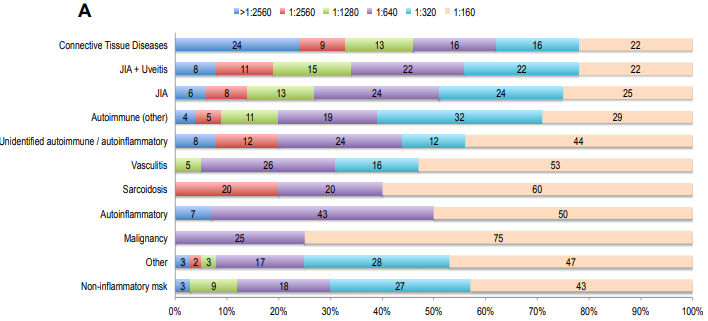ISR Autumn Meeting 2019
1st Place Clinical Oral Presentation

Charlene Foley
19A181
Can high ANA titre combined with clinical features predict developing autoimmune conditions in children?
Author(s)
Ovgu Kul Cinar, Charlene Foley, Ali Al-Hussaini, Kimberly Gilmour, Matthew Buckland, Muthana Al Obaidi
Department(s)/Institutions
Great Ormond Street Hospital for Children NHS Trust, Department of Paediatric Rheumatology, London, UK Imperial College School of Medicine, London, UK Great Ormond Street Hospital for Children NHS Trust, Department of Immunology, Octav Bognar Laboratories, London, UK
Introduction
Antinuclear antibodies (ANA) are autoantibodies that recognise cellular antigens found predominantly in the cell nucleus. They are associated with numerous autoimmune diseases such as systemic lupus erythematosus, but may also be found in infectious diseases, malignancies and healthy individuals.
Aims/Background
ANA is routinely requested as part of an initial work-up for autoimmune conditions. In healthy children (5-18%), ANA titres of 1/80 to 1/320 have been reported. Over time proportion will decrease in titre or disappear. A prospective study of healthy children with positive ANA found that children who developed autoimmune disease had clinical features at presentation. Therefore, the usefulness of a positive ANA result for diagnosing autoimmune conditions is limited without clinical correlation.
The aim of our study was to assess whether high ANA titre and clinical features at first presentation could predict final diagnosis.
Method
A single centre (GOSH), retrospective study. The immunology laboratory provided a list of positive ANA results. A retrospective chart review was performed to ascertain presence or absence of clinical features at presentation under the five following titles: Arthritis, skin involvement, eyes, CNS involvement and raynaud’s. We then reviewed the last clinical contact to document confirmed diagnosis.
Results
We performed a retrospective chart review on 1354 children (67% female; median age 7.5 years (0.1-17.5); median follow-up 4.8 years (0-18)) with positive ANA results (titres 1/160, 1/320, 1/640, 1/1280, 1/2560 and >1/2560). Figure 1A summarises the ANA titres observed in our cohort. Figure 2A reports ANA titres at first presentation in relation to final diagnosis. A titre of 1/640 or above was most commonly seen (>50%) in children with an autoimmune rheumatology condition. In fact, children with the highest titre (>1:2560) were significantly more likely to be diagnosed with one of these conditions. Finally, we looked at the number of presenting features and correlated with final diagnosis. Those diagnosed with CTD were most likely to present with more clinical features (p<0.0001).
Conclusions
This study suggests that, patients presenting with higher ANA titres and a combination of clinical features at presentation should be assessed systemically and followed-up as they may have increased risk of an autoimmune rheumatological diagnosis.


